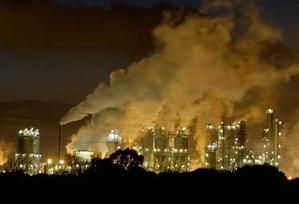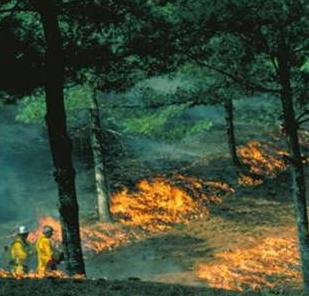
 |
SCIENTIFIC EVIDENCE
|
|---|
Through the study of ancient ice cores from Antarctica it is possible to compare atmospheric concentrations of the dominant greenhouse gas, carbon dioxide (CO2) in the atmosphere with temperature variations over the past 400 thousand years of the earth's history (Fig 1). A visual comparison of the two trends indicates a very tight connection between their performances, with fluctuations in one plot almost exactly mirrored in the other for more than 400 thousand years. as the Industrial Revolution takes off, atmospheric CO2 concentrations begin an unprecedented upward climb, rising rapidly from 280 ppmv (parts per million by volume) in the early 1800s to a current level of 376 ppmv, 77 ppmv above the highest concentrations previously attained in the course of the preceding 400 thousand years. |

|
|---|
 |
Figure 1. CO2 and Temperature. Barnola et al, 2003; Jouzel/Petit et al; Keeling et al; Neftel/Friedli et al. Data from Oak Ridge National Laboratory. |
Noting these trends, and recognizing the potential for dramatic changes in the climate due to continued unchecked accumulation of greenhouse gases in the atmosphere, the World Meteorological Organization (WMO) and the United Nations Environment Program (UNEP) established the Intergovernmental Panel on Climate Change (IPCC) in 1988. The purpose of the IPCC was to objectively review existing and developing peer-reviewed scientific literature to form an objective evaluation about the risk of human-induced climate change.
After years of investigation and in consultation with thousands of scientists, the IPCC was able to write, in its Second Assessment Report in 1995, that climate has changed over the past century and that the twentieth century had a mean temperature “at least as warm as any other century since 1400 A.D.” Their report noted that the dramatic increase in carbon dioxide concentration in the atmosphere over the past 150 years (from about 280 parts per million to about 376 parts per million) is largely due to anthropogenic (human-caused) effects and concluded that “the balance of evidence suggests a discernible human influence on global climate.” Their models predicted a rise of 1.8 to 6.3 degrees Fahrenheit in the global mean surface temperature during the next century, with sea-levels expected to rise by 6 inches to 3 feet by 2100. (IPCC 1995). The conclusions of the IPCC gained broad support in the world scientific community and, in the summer of 1997, a letter signed by 2,600 scientists called for the United States to take a leadership role in reducing greenhouse gas emissions to diminish the likelihood of intense, continuous global warming.
The Third Assessment Report of the IPCC was released in 2001, incorporating new research undertaken in the five years since the Second Assessment Report. Increased confidence in evolving modeling techniques lent added weight to the linkage between rising temperatures and continued greenhouse accumulations.
Using Computer Models to Predict Influences on Climate |
 |
 |
 |
Fig. 2. Comparison of observed temperature anomalies and modeled anomalies predicted under varying "forcing" scenarios. |
For example, recorded global temperature change can be compared with computer models that predict temperature change under different "forcing" scenarios, (with "forcing" signifying external influences on the solar radiative budget of the planet - greenhouse gases, aerosols, increased solar radiation, and other agents). Fig. 2 above compares observed temperature anomalies from the historic mean (red line) with the results of computer models that attempt to predict temperature based on the interactions of other environmental influences (gray line).
The top two charts in the figure illustrate that models using natural and anthropogenic influences alone [(a) Natural Forcing Only & (b) Anthropogenic Forcing Only] fail to match the observed record of temperature anomalies since 1866. But the combination of natural and anthropogenic models [(c) Natural + Anthropogenic Forcing] produces a close match to the measured data. This is seen as a clear "thumbprint" of human impacts on climate change.
Based on results such as these, the IPCC's 2001 report stated emphatically that "concentrations of atmospheric greenhouse gases and their radiative forcing have continued to increase as a result of human activities." Revised models for the future predict even higher anticipated temperature increases than did the First Assessment Report (2.5 degrees to 10.4 degrees Fahrenheit by 2100 under different likely scenarios), while estimates for sea-level rise, though significant, decreased slightly with refinements to the models used.
Other evidence of the reality of global warming continues to accumulate. Consistent with predictions of the IPCC since 1990, global average temperatures have indeed been rising while atmospheric CO2 increases at a rate of approximately 1.6 ppm per year (Fig. 3, below).
 |
Figure 3. Global Temperature & CO2 Concentration Since 1880. Data from NOAA's National Climate Data Center (NCDC) & Oak Ridge National Laboratory. |
The ten hottest years in the period of instrumental data
(since 1861) have all occurred since 1989. The warmest year was 1998,
followed by 2002 and 2003 (tied), 2001, 1997, 1995, 1990 & 1999 (tied)
and 1991 & 2000 (tied) (Climatic Research Unit,
University of East Anglia), and it is now generally recognized that
the 1990s was the warmest decade and 1998 the warmest year in the
instrumental record (Fig. 4, below).
 |
Figure 4. Global Temperature Anomalies (deviation from the 1880 - 2004 mean). Data from the National Climate Data Center (NCDC). |
The global monthly temperature record for each month of the year over the history of instrumented data has occurred since 1997 (Fig. 5, below).
 |
Figure 5. All record global monthly temperatures have occurred since 1997. Data from University of East Anglia, Climatic Research Unit. (Select image for larger version - 74KB. Opens in a new window.) |
Other global events are suggestive of climatic changes that are likely to become more prevalent under a changing global climate regime. Glaciers are present on every continent other than Australia and function as reasonably well-distributed indicators of changing global temperatures. Worldwide, glaciers and icefields have been shrinking and receding for at least the last century. The collapse of the 1250 square mile Antarctic Larsen B ice shelf in 2002 was just one of the more spectacular instances of a phenomenon that is likely to become more frequent in a warmer world. Melting of the Antarctic ice sheet is an event long predicted by climate scientists as an indication of a warming atmosphere (Gelbspan 1997).
The northern Arctic region appears to be even more vulnerable than the
Antarctic (which may actually see increases to its ice sheet due to
increased precipitation under a changing climate regime) and in a 2004
report by the Arctic Monitoring and Assessment Programme (AMAP), (Impacts
of a Warming Arctic: Arctic Climate Impact Assessment), the list
of Arctic change due to warming includes such phenomena as decreases in
sea ice, increasing precipitation and river discharge, thawing of glaciers
and permafrost, and changes in plant and animal abundances and
distributions.
While it is impossible to establish a direct causal link between greenhouse gas accumulation and individual, relatively short-term climatic events, it is certain that we have been experiencing increasing numbers of climatic events unprecedented in the human experience.
It is also certain that many of the greenhouse gases, including carbon dioxide and methane, have lengthy residence times in the atmosphere and that we will continue to be affected for years or even centuries to come by the atmospheric burden we are creating today. (For comments on the role of scientific uncertainty in climate change policy, see Dr. John Holdren's address at the White House Conference on Climate Change October 6th, 1997.) Source: http://www.whrc.org |
|---|
 |
 |
|---|
|
||||||||||||
|---|---|---|---|---|---|---|---|---|---|---|---|---|
|
|
||||||||||||